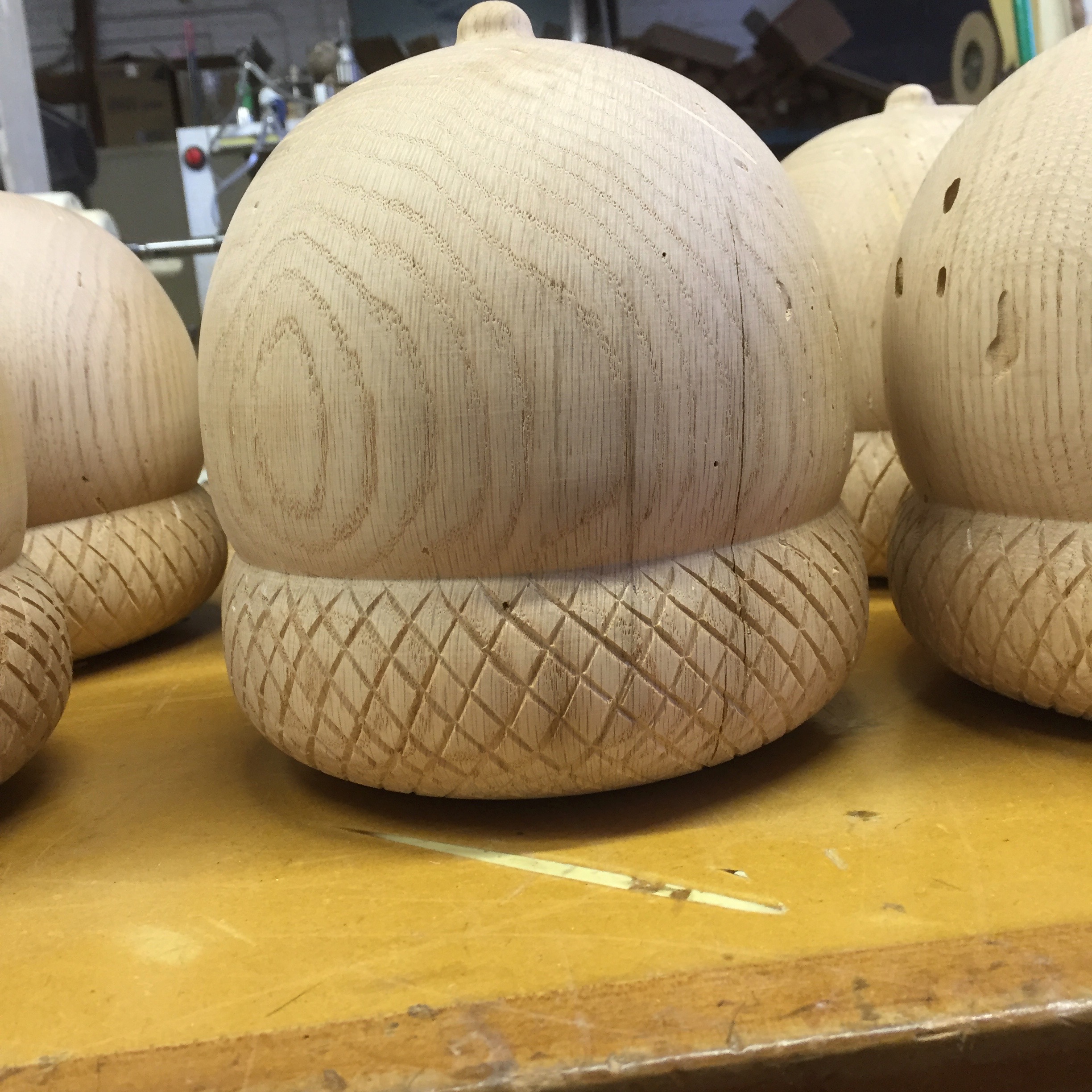
These are new parts made from reclaimed oak being used on a timberframe construction. Jim turned the acorns and I added the cross-hatching. The parts are approx. 9 inches in diameter. There's a video, when I find it, I'll include it here.
There haven't been a lot of restoration carving projects lately, which is good since I've been pretty busy, but sad because they are a nice change of pace. This last project, though the parts are small, was a big one. Replace six small finials that had gotten broken off the top of a cabinet piece. I only saw the top piece--a massive rectangle of crown molding with six small finials, one at each corner plus two on either side of a large finial in the center. Because the piece is so large, the guess is that movers didn't realize that it was not attached to the cabinet and somehow managed to break off all the finials atop its crown. The center final could be repaired without too much difficulty, but the smaller ones had been turned from the ends of corner blocks used assemble the crown molding. Rather than replace the corner blocks as well, Jim made the replacement finials with a tang. He then drilled matching holes in the cornerblocks to receive the finial.
There are 24 reeds and 36 beads carved into each finial, which made layout time consuming, even with Jim's good indexing setups. We had to eyeball the divide between two beads since he only had an eighteen-point index wheel, but the beads are so tiny, I don't think it shows. The whole finial is no longer than my cell phone; the beads are about an eighth inch in diameter. Tiny, precise stuff. Not a whole lot of room for error, though I wonder how much it gets appreciated on the top of a big cabinet. The replacements are carved from pattern-grade mahogany: clear, straight grain, easy to carve and holds detail well. While I can't say that the original finishing was masterful, I do wonder how well the new finish matches. Ah, well, the color is close enough and, as I mentioned before, no one should be inspecting these close up.
 On my way into work this morning, I followed an unusually fitted-out truck and trailor combo. I didn't get a photo (I was driving), but the impression it made will stay with me for a while, at least. I'm not sure what the equipment was for, but I guess it plays a roll some part of paving. Much was stained black and hard to recognize. It might also have been something to do with landscaping, but I don't think so. What fascenated me most and held my attention was the large tank mounted on the truckbed. The tank itself was black with the words "WATER WATER" in bright red across the back.
On my way into work this morning, I followed an unusually fitted-out truck and trailor combo. I didn't get a photo (I was driving), but the impression it made will stay with me for a while, at least. I'm not sure what the equipment was for, but I guess it plays a roll some part of paving. Much was stained black and hard to recognize. It might also have been something to do with landscaping, but I don't think so. What fascenated me most and held my attention was the large tank mounted on the truckbed. The tank itself was black with the words "WATER WATER" in bright red across the back.
Now, I know that there are lots of kinds of water: hot water, cold water, ice water, sea water, fresh water, gray water, ground water. But never had I seen or heard of water water. I reasoned that it must be the purest, most chemically consistent form of water—absolutely neutral so that the standard adjectives, hot, cold, wet, clean, dirty, did not apply. I felt honored to have been in the presence of such a notable substance. I wondered about the source of such liquid.
Of course, I also thought about the possibility that someone had been given two sets of labels and rather than sticking one to each side of the tank, chose to slap both on the back. But I quickly dismissed that idea as too mundane.
We've begun the photography for the next batch of Three Leg Vessels. There are four in this batch, with a few more still more left in the workshop to complete. With the first batch, I wanted to have video, but never got that far. However, this time, with the help of Nate Skinner and the YouTube Capture app for my iPhone, creating a simple video was pretty easy. I still have to get some still shots before I'm done, but here's one of the videos to enjoy.